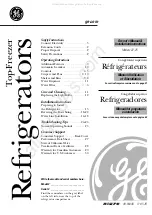
Different storage zones
Natural air circulation gives rise to dif-
ferent temperature zones inside the re-
frigerator section. Cold, heavy air sinks
to the lowest section of the appliance.
Make use of the different zones when
placing food in the appliance.
Coldest zone
The coldest zone in the refrigerator sec-
tion is directly above the vegetable
containers.
Use this for all delicate and highly per-
ishable food, e.g.
– fish, meat, poultry,
– sausage products, ready meals,
– dishes or baked goods containing
eggs or cream
– fresh dough, cake mixtures, pizza or
quiche dough,
– soft cheese and other dairy prod-
ucts,
– pre-packed vegetables and other
fresh food with a label stating it
should be kept at a minimum temper-
ature of 4 °C.
Warmest zone
The warmest zone is in the top section
of the refrigerator door. Use this for stor-
ing butter and cheese.
Do not store explosive materials in
the appliance or any products con-
taining combustible gas (e.g. spray
cans). Danger of explosion.
If storing alcohol with a high per-
centage proof, make sure it is tightly
closed, and store upright.
Do not store cooking oil in the refrig-
erator door.
Traces of oil can cause stress
cracks to occur in the plastic com-
ponents in the door.
Food must not touch the back wall of
the appliance. Otherwise it may
freeze to the back wall.
Food which should not be
stored in a refrigerator
Not all food is suitable for refrigeration.
These include:
– Fruit and vegetables which are sensi-
tive to cold, such as bananas, avo-
cado pears, papaya, passion fruit,
aubergines, peppers, tomatoes and
cucumbers
– Fruit which is not yet ripe
– Potatoes
– Some hard cheeses
Using the refrigerator section efficiently
19
















































